Bulletin – September 2013 Australian Economy Partial Mortgage Prepayments and Housing Credit Growth
- Download the article 726KB
Abstract
Changes in lending rates have an important influence on the pace at which households prepay their mortgages. This has implications for housing credit growth. The effect of the fall in lending rates since October 2011 on prepayments is by itself estimated to have led to a ½ to ¾ percentage point reduction in year-ended housing credit growth as of June 2013.
Introduction
One of the channels by which monetary policy affects the economy is through its effect on the price of credit. Other things equal, when lending rates fall, demand for credit increases and, as long as supply is not a constraint, credit growth can be expected to rise. During the most recent monetary policy easing phase, the value of housing loan approvals as a share of outstanding housing credit has risen, yet the pick-up in housing credit growth has been modest by comparison. One of the possible factors contributing to this divergence is an increase in the rate at which households are repaying their mortgages.
When lending rates fall, borrowers with variable-rate mortgages have three options: they can choose to reduce their payments to the lower minimum scheduled payment; maintain their existing payments; or even pay some higher amount. The extent to which borrowers adjust their payments depends on a number of factors, including the different processes lenders have for adjusting these payments, the level of lending rates at the start of an easing phase, and the perceived permanency of any reduction in lending rates.
A partial mortgage prepayment occurs when a borrower repays some, but not all, of a housing loan ahead of schedule. Such payments can be made on a regular basis, or as a one-off excess repayment. Most prepayments of loan principal are paid by borrowers with variable-rate loans. These loans account for about 85 per cent of outstanding housing credit. There is generally a limit to how much Australian borrowers are able to prepay on fixed-rate mortgages before they incur some penalty, although it is worth noting that fixed-rate terms are typically one to three years, after which these loans are usually rolled over into variable-rate loans. For this reason, the effect of prepayments on housing credit growth is likely to be larger in those economies that have a high proportion of variable-rate mortgages, such as Australia, Canada and the United Kingdom.
Investors do not have the same incentives as owner-occupiers to make prepayments owing to factors related to taxation. For investors, the tax benefits accruing from negative gearing diminish as the loan balance declines because of the lower interest deductions that can be used as an offset to rental income. Nonetheless, information from banks suggests that investors do make some prepayments.
This article discusses the influence of banks’ mortgage payment options and policies on prepayments before examining the empirical evidence. These findings are then compared with the results from two simulations, which estimate the effect of prepayments on housing credit growth. The analysis focuses on isolating the effect of prepayments on housing credit, rather than the effect of the reduction in lending rates on the demand for new loans.
Prepayments: Bank Processes and Customer Behaviour
Borrowers' prepayment behaviour can be affected by the processes and policies of their lenders, and in particular how lenders change scheduled mortgage payments following a change in lending rates. Australian lenders offer two main mortgage payment options to their customers. The first links payments to the minimum required to amortise the loan over its remaining term. These payments vary with lending rates. The second and more prevalent option is for borrowers to fix the level of payments on the mortgage until either the bank or the borrower decides to change the level of payments. These payments are set at origination, at a level at or above the minimum, so that the loan principal is repaid fully by the time the loan is scheduled to mature (assuming no change in interest rates). If interest rates increase, the bank may choose to increase the level of payments to ensure that the loan is fully paid off by its scheduled maturity date. If lending rates decline, borrowers can elect to take two courses of action. They can either continue to make the same payment, in which case their prepayments increase by an amount equal to the reduction in lending rates accruing on the outstanding balance. Alternatively, they can choose to nominate a lower payment level (within the limits stipulated by their lender). Anecdotal evidence suggests that about half of these borrowers have reduced the level of their scheduled payments since October 2011.
Policies regarding the timing of changes to borrowers' scheduled mortgage payments following changes in lending rates vary considerably between lenders. These policies can also depend on whether lending rates increase or decrease. For those borrowers who make payments linked to the minimum payment level, they will make:
- no additional prepayments if their bank immediately decreases scheduled mortgage payments following a reduction in lending rates (illustrated as ‘Alternative A’ in Graph 1); or
- temporary additional prepayments if their bank decreases scheduled mortgage payments infrequently (e.g. after a few changes in lending rates or annually; ‘Alternative B’ in Graph 1);
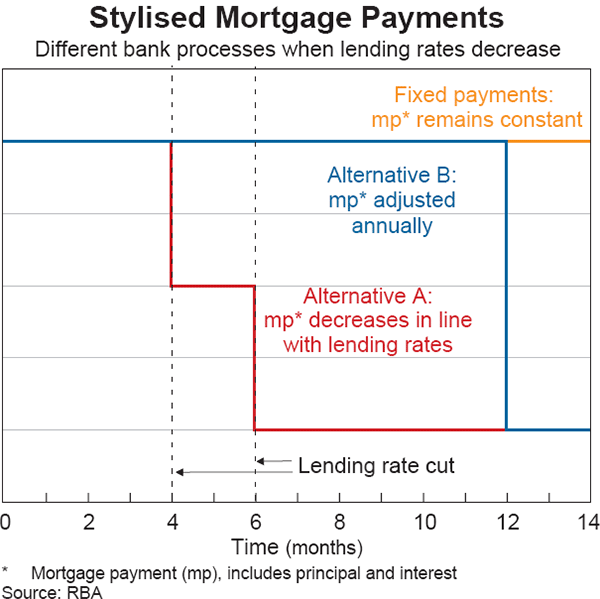
A borrower's decision to deviate from their bank's default arrangements or to change their payment amount is also influenced by the frequency with which the lender notifies its customers of a change in lending rates, as well as the ease with which borrowers can change their mortgage payments (e.g. in a branch, online, by telephone or by post).
Measures of Partial Prepayments
There are two main ways of estimating partial prepayments in Australia: the partial prepayment rate calculated from data reported by banks to APRA on a quarterly basis; and implied net principal payments based on the difference between housing loan approvals (net of refinanced owner-occupier loans) and housing credit growth.
The partial prepayment rate of each of the banks (based on APRA data) varies considerably.[1] This is partly due to the fact that following a change in lending rates, some banks do not immediately change the level of mortgage payments that borrowers are expected to make. Consequently, even though borrowers may be repaying their loan faster after a reduction in lending rates, some lenders may not report higher partial prepayments because there is no difference between the level of payments the lender has set for the borrower and what the borrower actually pays (which is a consequence of some of the bank processes outlined above). Therefore, as lending rates decline, the rate of partial prepayment reported by some banks may be understated.
The partial mortgage prepayment rate based on these data (on a four-quarter rolling average basis) increased by 0.9 percentage points between the September quarter 2011 and June quarter 2013 (Graph 2).[2]

Prepayments can also be gauged by looking at changes in implied net principal payments. This measure is only a rough proxy for prepayments since it is also affected by factors other than partial prepayments, such as variations in redraws and scheduled principal repayments (see Table A1 in Appendix A). Another problem with the implied net principal payments measure is that some loan approvals can be cancelled and the timing between an approval and a drawdown of a loan can vary significantly.
The implied net principal payments measure indicates that prepayments increased by 0.2 percentage points between the September quarter 2011 and June quarter 2013 (Graph 3). This is considerably less than the 0.9 percentage point increase indicated by the partial prepayment rate discussed above.
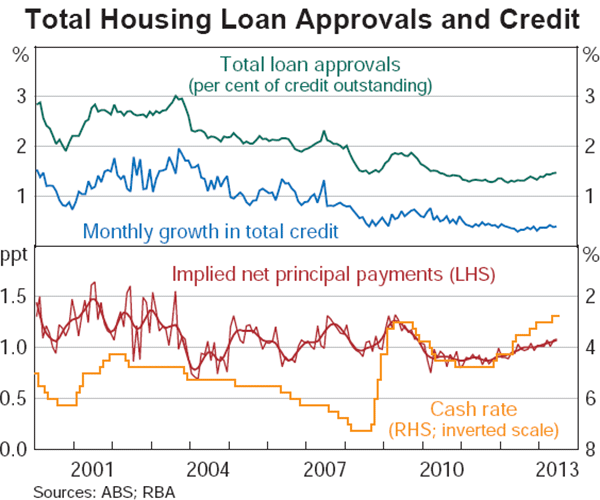
Partial Mortgage Prepayment Simulations
Simulations can also be used to obtain estimates of the impact of decreases in lending rates on partial mortgage prepayments and housing credit growth. This article looks at two simulations: the first uses a hypothetical loan portfolio; while the second uses historical housing credit and loan approvals data. Both simulations focus on borrowers with variable-rate loans and assume that loan payments are kept constant when lending rates fall. For this reason, both simulations estimate the upper bound of the effect of prepayments on housing credit growth.
1. Loan portfolio simulation
The loan portfolio simulation examines the effect of a decrease in lending rates on the repayment profile of a single credit-foncier loan, the most common type of mortgage in Australia, with a contractual term of 25 years. This profile is then used to construct a portfolio of loans, differentiated by age, to assess the impact of prepayments on aggregate housing credit growth in Australia.
Single loan view
Under a credit-foncier loan contract, the borrower must repay the original principal and pay applicable interest on the outstanding balance over an agreed maximum term by making regular payments. This payment schedule leads to a non-linear principal repayment profile, with principal repayments being a lower portion of total payments at the start of the loan and a higher portion towards the end of the loan (Graph 4).
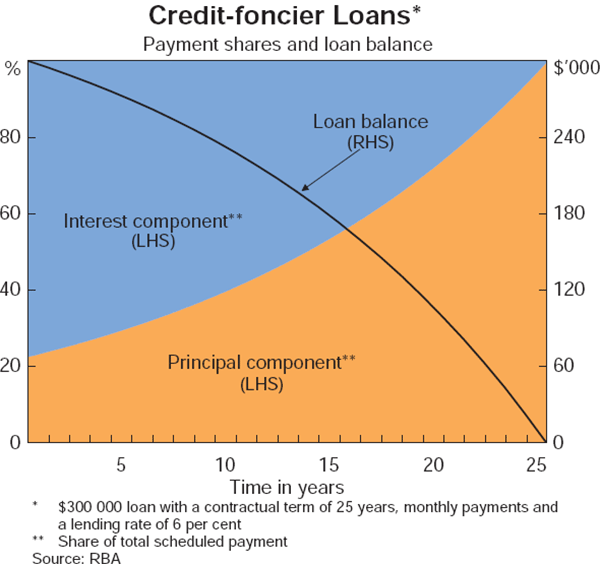
If lending rates fall, borrowers with variable-rate loans might reduce their scheduled payments, such that the loan still matures at the same time, but with borrowers incurring lower interest costs over the remaining life of the loan (the blue line in Graph 5). Alternatively, if borrowers keep their payments constant, the loan is fully repaid earlier than originally scheduled (the green line in Graph 5). For example, if lending rates decrease from 6 per cent to 5 per cent for a $300,000 loan in the third year of a 25-year contract and the borrower keeps their monthly payments constant, the loan will be fully repaid by year 22.[3]

To measure the effect of prepayments, two scenarios are compared. In the first scenario, principal repayments are calculated in each period if lending rates are unchanged and borrowers made their scheduled loan payments for the remaining term of the loan (the counterfactual scenario). In the second scenario, principal repayments are calculated in each period assuming that borrowers do not change their loan payments after lending rates are reduced, thereby accelerating the repayment of the outstanding loan balance.
It is assumed that mortgage payments are made annually (to simplify the analysis) and that lending rates decrease from 6 per cent to 5 per cent. In the year immediately following the decrease in lending rates, the rate of prepayments relative to the outstanding loan balance is equivalent to the change in lending rates (i.e. 100 basis points), regardless of the age of the loan. In subsequent periods, however, the age of the loan affects the magnitude of prepayments (Graph 6). Prepayments on younger loans continue to increase due to the larger loan balance on which the interest savings apply; these interest savings are compounded over time. In contrast, for older loans, there is a point after which prepayments tend to diminish. This is due to the increasingly rapid decline in the loan balance as the loan ages. As a consequence, any interest savings apply to a much smaller loan balance, and principal repayments tend to have a larger effect than the compounding of the interest savings.
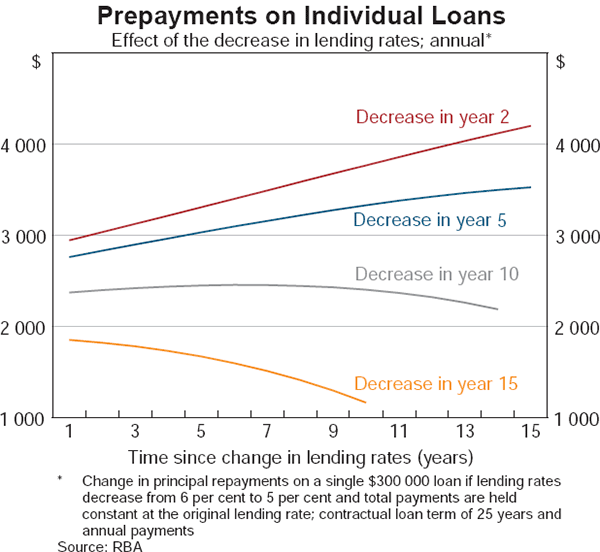
Portfolio view
To estimate the aggregate effect of prepayments on a portfolio of loans, the prepayment profiles of single loans with terms of 1 to 25 years are weighted by an empirical age distribution of variable-rate loans (Graph 7).[4] The portfolio view also requires an assumption about the rate of housing credit growth in the absence of any partial prepayments. This approach ensures that after a reduction in lending rates, the analysis takes into account any new loans entering the credit pool (it also helps to calibrate the prepayment profile of individual loan age cohorts relative to the growth of credit). Since new loans are entering the pool in each period, it is assumed that prepayments are made only on the outstanding stock of loans at the time of the decrease in lending rates. Therefore, new loans diminish the prepayment effect on the portfolio.
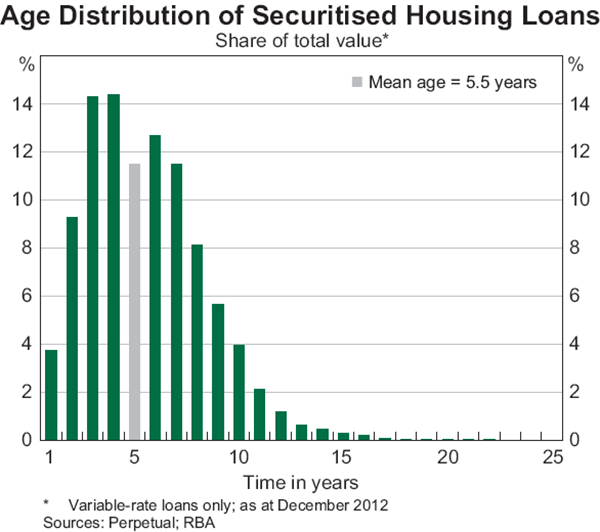
The portfolio simulation results suggest that in the first year following a 100 basis point decrease in lending rates, prepayments reduce growth in variable-rate housing credit by 1 percentage point, as all loans experience the same effect. Under the assumption that fixed-rate housing loans and some interest-only loans are less susceptible to prepayments, this is equivalent to a 0.5 to 0.7 percentage point reduction in the year-ended growth rate of total housing credit.[5]
In subsequent years, however, the assumed growth of housing credit substantially affects the extent to which prepayments have an effect on housing credit (Graph 8). When the flow of new loans is large, the effect of prepayments on housing credit growth tapers off more quickly than in lower growth environments. This is because the loans that experience prepayments diminish rapidly as a share of outstanding loans. In contrast, when there is a lower flow of new loans into the credit pool, the effect of prepayments is much higher relative to the outstanding stock of housing credit. In fact, the effect can be higher than the decrease in lending rates for a number of years after a reduction in lending rates because of the compounding of interest savings.
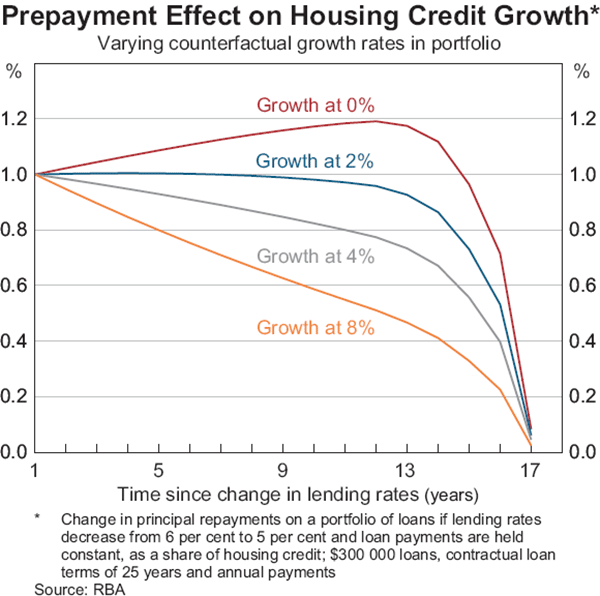
2. System-level simulation
In the system-level simulation, a model is used to estimate the effect of the reductions in lending rates on monthly prepayments and ultimately on housing credit growth since late 2011. The simulation then projects these effects from July 2013 to March 2014 assuming no further changes in lending rates and a constant growth rate for housing credit.
The central principle of this simulation is that only those loans outstanding prior to a reduction in lending rates experience an increase in prepayments as a result of the interest savings. For each reduction in lending rates, we calculate a projection of interest savings on loans outstanding at the time of the reduction in lending rates. To do this, however, the flow of new loans after a reduction in lending rates has to be taken into account as the interest savings do not apply to new loans written after lending rates decline. Therefore, in each period the balances of new loans written are subtracted from the total stock of housing credit. We assume that the new loans amortise according to the credit-foncier schedule over a 25-year term and follow a profile for partial prepayment behaviour in line with past patterns. The change in lending rates is applied in each period to the resulting balances on loans that existed at the time that lending rates were reduced. These calculations produce eight projections of interest savings (for the eight reductions in lending rates since late 2011). For each period, the interest savings across each projection are added to produce an estimate of the effect of interest savings on housing credit growth.
Overall, the simulation suggests that the cumulative effect of the 165 basis point decrease in the average outstanding variable rate between October 2011 and June 2013 on prepayments would result in about a 1 percentage point reduction in housing credit growth over the period. Over the year to June 2013, the effect on housing credit growth is around 0.8 percentage points (Graph 9). Assuming that the flow of new loans relative to housing credit is constant in each period, that there are no further changes in lending rates, and all interest savings are used to partially prepay mortgages, the effect of prepayments on year-ended housing credit growth is estimated to peak in mid 2014 at around 1 percentage point (i.e. year-ended housing credit growth is forecast to be around 1 percentage point lower than it otherwise would have been; Graph 10).
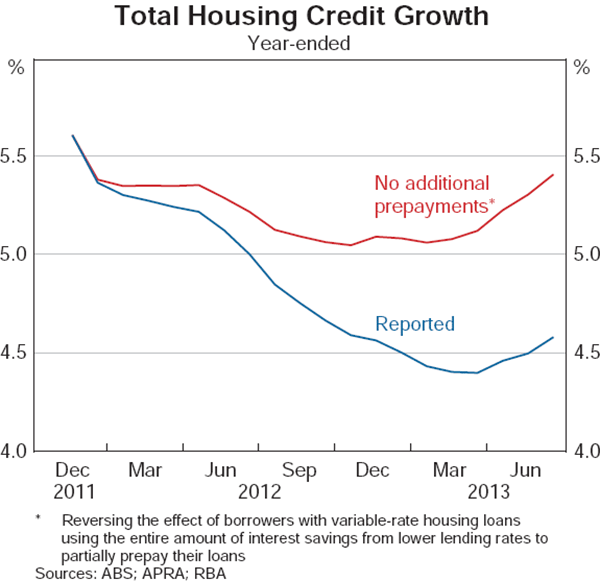
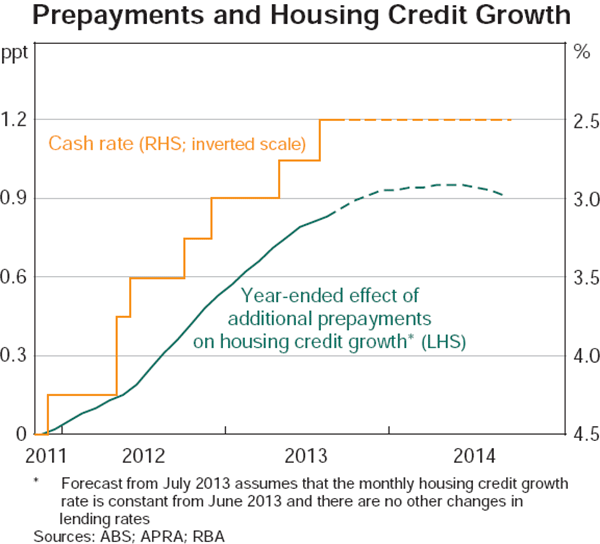
Conclusion
In an environment where lending rates are falling, higher partial prepayments on mortgages reduce the rate of housing credit growth below what it otherwise would be. This article attempts to quantify this effect over the recent monetary policy easing phase.
Behavioural aspects play an important role, as borrowers can use interest savings to either spend (for consumption) or save (via accelerated prepayment of debt or via the accumulation of assets). This behaviour, in turn, is influenced by banks' payment options and policies.
When considering the effect of this behaviour, a range of estimates of the likely upper bound of the prepayment effect on housing credit growth have been calculated. The estimates suggest that housing credit growth over the year to June 2013 has been lower by as much as 0.8 percentage points as a consequence of the increase in prepayments. If there are no further changes in lending rates, the peak effect of prepayments on year-ended housing credit growth of around 1 percentage point will be likely to occur in mid 2014.
The difference between the estimates of prepayments based on data reported by the banks and the loan portfolio simulation, which assumes that all borrowers make partial prepayments, suggests that about 90 per cent of the interest savings have been used for prepayments between October 2011 and June 2013. On the other hand, liaison with lenders suggests that this ratio could be as low as 50 per cent. Using this range implies that prepayments have reduced housing credit growth by between ½ and ¾ percentage points over the year to June 2013.
Appendix A
| Change in housing credit = | + new loan drawdowns + accrued interest − interest payments − net principal repayments + shortfalls in payments |
|---|---|
| where net principal repayments = |
+ scheduled principal repayments + partial principal prepayments + full principal prepayments − redraws − increases in borrowing through refinancing and lines of credit |
|
Source: RBA |
|
Footnotes
The authors are from Domestic Markets Department. [*]
The quarterly partial prepayment rate is calculated as the quarterly flow of partial prepayments, relative to the stock of housing credit outstanding at the start of the quarter, which is reduced by any scheduled principal repayments made during the quarter. [1]
Prepayment data are only available for a short time period, so cannot be fully adjusted for seasonal effects. A four-quarter average is used to partly address this issue. [2]
In this case, if there was already a significant level of partial prepayment (in addition to prepayments as a consequence of a change in lending rates), a reduction in interest rates would lead to a lower level of additional prepayments relative to other loans of the same age that have not been partially prepaid. While most Australian borrowers repay their mortgage ahead of schedule, for simplicity, it is assumed that prior to the reduction in lending rates, borrowers had been repaying their loan as scheduled – that is, no mortgage buffers had been accumulated. [3]
The age distribution is obtained from securitisation trust data. This distribution may be skewed because loans that are securitised, particularly by banks, are often older. The distribution also reflects varying issuance activity of residential mortgage-backed securities, particularly during recent years. However, the average age is broadly consistent with information from liaison with lenders. [4]
Variable-rate mortgages – adjusted for the share of interest-only loans where borrowers are assumed to prepay – account for about 70 per cent of housing credit outstanding. Due to the way that loans and deposits are reported, housing credit is not reduced by deposits in offset accounts. There are no data available to help determine the effect on credit from direct prepayments and those prepayments that occur because of the interest savings resulting from deposits in offset accounts. Therefore, a range is given based on two assumptions: the lower end is equivalent to all borrowers with offset accounts (around 30 per cent of loans outstanding) using prepayments to increase deposits in these accounts (which reduce the interest burden on the mortgage but do not reduce credit outstanding); while the upper end is equivalent to all borrowers using prepayments to reduce the balance of the loan (and hence credit). [5]